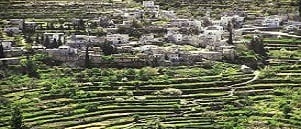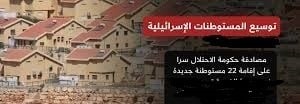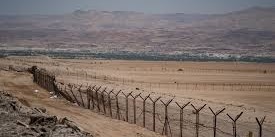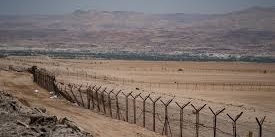By: Madeeha Al-A’raj
The National Bureau for Defending Land and Resisting Settlements stated in its latest weekly report , that the settlement activities of the Occupation State don’t stop even during wartime, as the Israeli Minister of Finance, Smotrich announced at the beginning of this month the establishment of a new settlement on the lands of the Battir village in the Bethlehem Governorate. He said in a post on the ‘X’ platform that linking the ‘Gush Etzion settlement bloc’ in the southern West Bank to Jerusalem is a ‘national mission and a historic moment’ and pointed out that the new settlement ‘Nahal Helitz’ will be within the ‘Gush Etzion settlement bloc’, and that the Blue Line team in the Civil Administration, which Smotrich control has completed its professional work and published a new Blue Line for the new settlement in ‘Gush Etzion, which means the start of the construction in the above mentioned settlement.
This new settlement, which is being planned to be built on Palestinian heritage sites, is one of five settlements that the Israeli government approved 2 months ago to be established in the West Bank, in response, it claims, to the Palestinian side’s appeal to international forums against the State of Israel, and the recognition of the State of Palestine by Norway, Spain and Ireland last May, and by Slovenia and Armenia a month later.
It is known that the World Heritage Committee of UNESCO has taken 3 important decisions in July 2021 regarding the state of preservation of Palestinian sites listed on the World Heritage list in danger, at a meeting held in the Chinese city of Fuzhou, which included the Old City of Jerusalem and its Walls, the site of Palestine, Land of Olives and Grapes, The Cultural Landscape of the Terraces of Southern Jerusalem – Battir, and Hebron – the Old City.
The decision of the World Heritage Committee regarding the World Heritage site Palestine, Land of Olives and Grapes, ‘The Cultural Landscape of the Terraces of Southern Jerusalem’ emphasized the exceptional importance of the site, and condemned the violations of the occupation authorities and the settlement activities targeting the site, starting with the establishment of settlement outposts, roads, and a plan to establish an industrial zone, a large part of which is located in the buffer zone of the World Heritage site on the lands of the town of Battir, which leads to significant damage to the World Heritage site and affects its exceptional universal values, integrity, and authenticity.
This came at a time when settlers began targeting the area, one of the hills of the Palestinian village of Battir, south of occupied Jerusalem; settlers built an illegal settlement outpost on the lands of the town, which is listed on the UNESCO World Heritage List. The Israeli occupation government at the time asked those in charge of the settlement outpost to evacuate because it was built without government approval and is therefore considered illegal under Israeli law.
The settlers did not comply with the request and it was not implemented. In fact, the settlers raised the Israeli occupation flag on a pole in the new settlement outpost, and several mobile homes and a sheep pen were placed in an area covered with olive trees owned by Palestinians, without the occupation authorities taking any action.
The outpost is not the only concern for Battir, the planned settlement of Helitz next door is quickly becoming a bigger concern. Helitz is one of 5 settlements deep in the West Bank that the Israeli government approved on June 27. The outpost and the Helitz settlement, which the occupation government approved and which are located within the UNESCO-protected area of Battir, are 1 of 4 sites inscribed on the World Heritage List in the occupied West Bank, and their inclusion on this list provides technical, legal and material assistance to protect them from any danger.
To give you an idea, the Battir agricultural terraces are supported by stone walls and ancient irrigation pools that collect water flowing from springs, and they have ancient irrigation canals that are more than 2,000 years old, which earned them the privilege of being listed on the World Heritage List in 2014. That year, UNESCO approved the State of Palestine’s request to recognize the ancient terraces in Battir as a World Heritage Site.
The request was submitted against the backdrop of Israel’s intention to build an apartheid separation wall in the area. The agricultural landscape in Battir has been preserved over the years, and Palestinian farmers continue to develop it. According to the environmental organization ‘EcoPeace’, whose members include people from Israel, Jordan and Palestine, the establishment of a new settlement in the place violates the restrictions imposed on it within the framework of the laws protecting World Heritage Sites.
The purpose of establishing the settlement of ‘Helitz’ is clear and is reflected in the statements of government officials and the positions of the settlers. It is to link the city of Jerusalem and its settlements to the ‘Gush Etzion settlement bloc’, which means isolating Battir with its cultural heritage and the neighboring Palestinian villages from the city of Bethlehem and the rest of the occupied West Bank, in a clear violation of the International Convention for the Preservation of World Heritage Sites, which Israel signed in 1999 and withdrew from seven years later, in response to the positions of the United Nations organization regarding Palestine’s membership in the organization and its defense, according to international laws and its obligations, of Palestinian heritage sites under threat.
To build this settlement, the Civil Administration published a map of the area ‘about 600 dunams and allocated it for the establishment of the aforementioned settlement within the borders of the Gush Etzion Regional Council. This comes within the framework of building the other four settlements, which the occupation government has approved since the outbreak of the brutal war on the Gaza Strip, and the accompanying construction of more than 8,000 housing units in settlements built on an area of 24,000 dunams, which the Blue Line team in the Civil Administration had classified as state land.
Chairman Yaron Rosenthal of Gush Etzion Regional Council praised the government’s approach and said that Helitz will create a continuum of Jewish settlement between Gush Etzion and Jerusalem. He noted with satisfaction that anyone walking from Gush Etzion to Jerusalem will only see Jewish settlements in response to accusations of harming the World Heritage Site in Battir.
He invoked myths and the sayings of soothsayers, saying: “The construction of the new settlement will take into account the environmental sensitivity of the Refaim Valley. For me, the heritage in the Battir area also requires the return of the Jews to the areas from which they were expelled at the end of the Bar Kokhba revolt, after thousands of years in which much Jewish blood was shed for those slaughtered by the Romans in the valleys of the area, we can preach that the sons have returned to their borders,” he claimed.
The construction of this settlement is not isolated from the general trend of the Netanyahu-Ben Gvir-Smotrich Government to move forward with destructive activities not only to prevent communication between Palestinians but also to impose as many restrictions as possible that would prevent the establishment of a viable Palestinian state. To prevent this communication, the extremist Israeli Minister of National Security Itamar Ben Gvir proposed last week, during a meeting of the security cabinet, imposing severe restrictions on the movement of Palestinians in the occupied West Bank. In that proposal, Ben-Gvir called for preventing Palestinians from moving in Area C entirely and limiting their movement to Areas A and B under the Palestinian Authority.
He reiterated that “the settlers’ right to life is superior to the freedom of movement of the Palestinians.” Smotrich, the leader of the Religious Zionism party, said via the X platform that his life’s mission is to build the Land of Israel and thwart the establishment of a Palestinian state that would endanger the State of Israel. He added, “This is not a political ‘issue’, it is a national and existential one.” That is why he took on the responsibility, in addition to his position as finance minister, for civil issues in “Judea and Samaria,” meaning the West Bank occupied by Israel.
Smotrich established his own authority in the headquarters of the Israeli Ministry of Defense in Tel Aviv, and appointed the extremist settler Hillel Rot as deputy head of the Civil Administration for Civil Affairs. In effect, Rot became the governor of the West Bank in all areas, after Smotrich granted him all the powers of the head of the Civil Administration in the Settlement Directorate, which became a political body in Smotrich’s ministry. After filling the positions of department heads in the Civil Administration, he appointed activists in the Religious Zionism Party in it and appointed an engineer from the Revava settlement as director of the planning office in the Civil Administration, which is the highest authority in the field of planning and construction in the West Bank.
To deepen his control over the Civil Administration, Smotrich dismissed the “legal advisor for Judea and Samaria” (the West Bank), who is subordinate to the military prosecution, and closed his department, after appointing more than 20 lawyers whose tasks include implementing the actual Judaization of the area. These lawyers are quickly changing the regulations with the aim of allowing the development of the area for Jews only.
Indeed, according to Israeli reports, during the past year and a half there has been zero planning for the 300,000 Palestinians living in Area C and zero building permits, in addition to the regular demolitions, including the demolition of water wells and schools. The declaration of state land has quadrupled, building permits have quadrupled, and random settlement outposts have been established without permits, amid a complete ban on law enforcement against settlers who violate building laws.
Among the forms of thieving on citizens’ lands to provide protection for settlers, the occupation authorities practice a policy of seizing their lands for so-called military purposes as they notified the seizure of about 18 dunums of lands from the villages of Asira al-Qibliya, Burin, and Madama, south of the city of Nablus, under the pretext of using them for military purposes, close to the ‘Yitzhar’ settlement, known for hosting large numbers of ‘price tag’ terrorists whom the occupation government calls ‘hilltop youth’.
The confiscated lands are located in Basin No. 8, the site of al-Marj and Jabal al-Nadhr from Burin lands, basin n. 4, the site of Khallet al-Marj, Bir al-Marj, and al-Aqida from Madama lands, and basin n. 1, the site of Lahf Salman from Asira al-Qibliya lands, this is not the first time, and it will not be the last, that Palestinian lands in the area have been seized, which is considered a prelude to turning them into a vital area for settlement activities for the most extremist settlement in the region.
A few years ago, the occupation army issued a decision to confiscate about 4,000 dunums of Palestinian land in the village of Asira al-Qibliya alone, for military purposes in the basins of Lahf Suleiman, al-Uqda, al-Burais, Khallet al-Naqr, al-Shaqiq, al-Krum, and the of al-Sahila, and their confiscation came under the pretext of military purposes. These confiscations for military purposes have one meaning, which is to impose a security cordon for a settlement from which terrorism is launched against towns and villages south of the city of Nablus, and from which the terrorists launched their attacks on the ‘Crystal Night” in Huwara in March of last year. This is a security cordon that prevents landowners from reaching their lands due to the permanent presence of the occupation forces.
On another level, the West Bank has witnessed over the past few days, an escalation in the acts of violence, vandalism and terrorism by settlers, alongside the brutal war waged by the occupation forces on cities and camps in the northern West Bank. The editorial staff of the Israeli Haaretz Newspaper described the situation in the West Bank in its editorial on the 8th of this month as savage, ‘without religion or faith’. The lives of the Palestinian residents, who are legally responsible for protecting the occupying power, the State of Israel, has become unsafe, even if they are just children.
Since Oct. 7, chaos has reigned in the West Bank. Settlers arrive in the village of Qariot, throw stones and burn agricultural land, and a 13-year-old girl is killed by Israeli army fire in her home. In the colloquial Israeli military language, ‘forces rushed to confrontations between dozens of Palestinians and dozens of settlers in the area, which included stone-throwing, and worked to disperse the disturbances in the area by firing into the air’.
It is not possible without an empty announcement that the army is ‘examining the circumstances of the girl’s death.’ So it is investigating. Haaretz adds, a direct line runs between causing the death of the girl and causing the death of human rights activist Aisha Nur Izgi Igi, a young woman with American and Turkish citizenship, who was shot dead by soldiers participating in a demonstration against the settlements in the town of Beita, near Nablus. In her case, it seems that they are trying to present a superficial appearance of a serious examination. She was an American, not just a Palestinian child living under occupation.
List of Israeli Assaults over the Last Week Documented by the National Bureau:
Jerusalem:
- Forcing citizen Raed Al-Rajabi to demolish his two-apartment house, under the pretext of building without a license in the Beit Hanina town, north of occupied Jerusalem, and the demolishing the two-story house of citizen Mo’amen Abdul Sami Subaih in the Hizma town, northeast of occupied Jerusalem, and demolished a commercial store belonging to the Jerusalemitem Bassam Abdul Omari in the Al-Mashrou’ area, and handed over demolition notices for 3 other houses in the town.
- Demolishing a house containing a private garden and a swimming pool belonging to citizen Wael Al-Saifi, three commercial stores, and a 150-meter-long retaining wall belonging to citizen Bajis Al-Sheikh in the Biddu town, northwest of occupied Jerusalem.
- Assaulting the young man Daoud Wissam Hamouda, while he was on his way to workplace, he sustained injuries and bruises in various parts of his body. He was also electrocuted, and was found unconscious.
Hebron:
- Demolishing 18 houses in the Taybeh area in the Tarqumia town, each house measuring about 100m2 , and expelled approximately 35 families from their homes in the area, after declaring it a closed military zone in the area adjacent to the settlements of ‘Telem’ and ‘Adora’.
- Demolishing a house belonging to citizen Anis al-Natsheh in the Farsh al-Hawa area west of the city of Hebron, and a warehouse for building materials in the Bir al-Sufla area, belonging to citizen Shawqi al-Shamali from the Idhna town, with an area of 800m2, and a house, a water well, and retaining walls in the Khalidiya east of Yatta town, and damaged water tanks belonging to citizen Osama Ghanem Ahmed Abu Aram.
- Attacking citizens’ property and the water pipeline, vandalized water tanks and cave roofs, while the occupation authorities seized, under the name of a “military order,” a 767m2– plot of land in the village of Um al-Khair in the Shu’aib community in Masafer in order to build a settlement wall around the ‘Karmiel settlement’.
- Assaulting the head of the Susiya village council in Masafer Yatta, Jihad al-Nawaj’a, while he was driving his vehicle from the Wadi Ma’in area to the village of Susiya. He was admitted to Yatta Governmental Hospital for treatment after sustaining fractures in his ribs.
- Storming the Ma’in Well site in Masafer Yatta, prevented citizens from approaching the place or moving around it, set up a tent in the place, polluted the well water, and performed Talmudic prayers there.
Bethlehem:
- Demolishing 2 floors ‘the second and third’ of a house in the Ein Juwaizah area in the village of Al-Walaja, belonging to the citizen Basem Abd Rabbo, under the pretext of not having a license, and a tent erected on the ruins of a previously demolished house belonging to the citizen Ahmed Nasr Abu Al-Teen, bulldozed his land and uprooted trees, and notified a house of demolition belonging to the citizen Moh’d Sae’d Al-Sikh Al-Araj, with an area of 100m2.
- Storming the Dat Al-Nitaqayn Girls’ School in the Al-Khader town and wrote racist slogans on the facade of one of its classrooms.
- Chopping olive trees with an electric saw in the Khalayel Al-Loz area, southeast of Bethlehem, belonging to citizens from the Abayat family.
Ramallah:
- Bulldozing vast areas of land belonging to the village of Um Safa, estimated at about 200 dunums planted with olive and grape trees in the Jabal al-Ras area.
- Attacking citizens’ vehicles with stones near the “Beit El” settlement.
Nablus:
- Storming the Awarta village, south of Nablus, to perform Talmudic rituals in Islamic shrines.
- Attacking citizens’ homes in the village of Yatma and set fires around them.
- Notifying of the cessation of work on residential buildings under construction near Al-Najah Hospital and the Quran Academy in the north.
- Attacking the ‘Al-Yatmawi’ area near Mount Sabih in the Beita town, south of Nablus, which led to the outbreak of clashes.
- Chopping olive trees and damaged the fence of agricultural lands east of the village of Rojib, east of Nablus, while settlers attacked citizens’ vehicles and threw stones at them on the road near the “Yitzhar” settlement, south of the city of Nablus.
Salfeet:
- Demolishing a house under construction belonging to citizen Moh’d Hael, in the Deir Ballut town in the area called ‘Dahr Rijal’, while settlers from the ‘Yakir settlement’ broke about 12 olive trees in the ‘Khallet al-Najjara’ area west of Deirstiya, belonging ton citizen Musleh Yousef Mansour. Noting that about 20 olive trees were broken in the ‘Al-Mughibeh’ area, belonging to the same citizen.
- Notifying to stop construction on a playground and houses in the Rafat village, west of Salfeet.
Jordan Valley:
- Organizing a provocative march on St. 90 near the Al-Jiftlik village, north of Jericho, under heavy protection from the occupation forces, closed the road to Palestinian citizens and prevented them from passing, which obstructed movement and hindered farmers from reaching their lands.
- Occupying an abandoned house in the vicinity of the Bedouin community of Ras al-Ain, north of Jericho, and brought sheep and setting up a pen next to it, and a water tank.
- Demolishing an agricultural facility that included more than 5 agricultural ‘barracks’, used for palm trees and some for sheep, and uprooted palm trees in the Marj Na’ja village, north of Jericho.
- Attacking students of the Bedouin Al-Ka’abneh School in the Arab Al-Malihat community, northwest of Jericho, and prevented them from reaching their school.
 المكتب الوطني للدفاع عن الارض ومقاومة الاستيطان منظمة التحرير الفلسطينية
المكتب الوطني للدفاع عن الارض ومقاومة الاستيطان منظمة التحرير الفلسطينية




